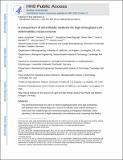A comparison of microfluidic methods for high-throughput cell deformability measurements
Author(s)
Urbanska, Marta; Muñoz, Hector E; Shaw Bagnall, Josephine; Otto, Oliver; Manalis, Scott R; Di Carlo, Dino; Guck, Jochen; ... Show more Show less
DownloadAccepted version (1.375Mb)
Publisher Policy
Publisher Policy
Article is made available in accordance with the publisher's policy and may be subject to US copyright law. Please refer to the publisher's site for terms of use.
Terms of use
Metadata
Show full item recordAbstract
The mechanical phenotype of a cell is an inherent biophysical marker of its state and function, with many applications in basic and applied biological research. Microfluidics-based methods have enabled single-cell mechanophenotyping at throughputs comparable to those of flow cytometry. Here, we present a standardized cross-laboratory study comparing three microfluidics-based approaches for measuring cell mechanical phenotype: constriction-based deformability cytometry (cDC), shear flow deformability cytometry (sDC) and extensional flow deformability cytometry (xDC). All three methods detect cell deformability changes induced by exposure to altered osmolarity. However, a dose-dependent deformability increase upon latrunculin B-induced actin disassembly was detected only with cDC and sDC, which suggests that when exposing cells to the higher strain rate imposed by xDC, cellular components other than the actin cytoskeleton dominate the response. The direct comparison presented here furthers our understanding of the applicability of the different deformability cytometry methods and provides context for the interpretation of deformability measurements performed using different platforms.
Date issued
2020Department
Massachusetts Institute of Technology. Department of Biological Engineering; Massachusetts Institute of Technology. Department of Mechanical Engineering; Koch Institute for Integrative Cancer Research at MITJournal
Nature Methods
Publisher
Springer Science and Business Media LLC